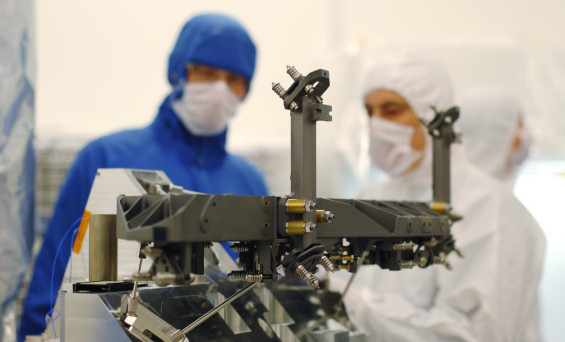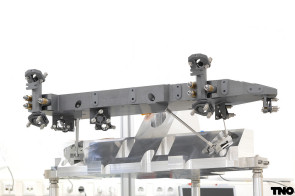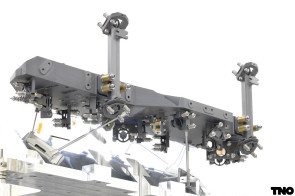#03: Gaia Basic Angle Monitor delivered for integration
11 April 2012
The protoflight models of the two Basic Angle Monitor (BAM) Opto-Mechanical Assembly (OMA) bars have been delivered to the spacecraft Prime Contractor and are being prepared for integration into the Payload Module (PM).Gaia will perform astrometric measurements of over one billion objects in the Milky Way and beyond. These measurements will be made using global, or wide-angle astrometry, where targets with large angular separations are observed simultaneously to link them in a network where each target is connected to a large number of other targets in all directions. This is in contrast to narrow-angle astrometry, where target positions are measured with respect to other targets in the same field of view. Narrow-angle astrometry is problematic for large-scale surveys, because the need to combine measurements obtained in separate fields introduces systematic errors and noise. Wide-angle astrometry avoids this need to combine measurements and eliminates the resulting errors.
 |
|
Gaia BAM OMA bar #2 being examined during a Delivery Review Board. |
The purpose of the Basic Angle Monitor
Wide-angle astrometry requires the measurement of large angular target separations by means of the simultaneous observation of two fields of view, which are, in turn, separated by a large angle. This allows the determination of absolute trigonometric parallaxes and avoids the need to transform relative parallaxes to absolute distances. Gaia achieves this by having two telescopes with their fields of view separated by 106.5°, which is referred to as the 'basic angle'.
The various mirrors that make up the two telescopes are mounted on a single toroidal structure. Both the payload structure and the mirrors are manufactured from sintered silicon carbide, which offers high specific stiffness, low thermal expansion and high thermal conductivity. The payload is designed to be athermal, but variations in the telescope lines of sight will still arise due to fluctuating thermal gradients within the payload structure.
The design of Gaia is such that its astrometric measurements will be accurate to better than 24 micro-arcseconds (µas) for targets brighter than magnitude 15; this is comparable to the diameter of a human hair at a distance of 1000 kilometres. To obtain this accuracy, it is necessary to correct for variations in the basic angle caused by thermally induced deformations of the Gaia payload structure. The BAM allows these corrections to be performed by continuously measuring the angle between the two telescope lines of sight.
How the Basic Angle Monitor works
The BAM OMA consists of two bars that are mounted on the Gaia payload torus via isostatic mounts; one being positioned opposite each of the two main mirrors. Each bar comprises a structural element supporting the various beam-folding mirrors and, on bar #2, the light source, collimating optics and beam splitters. The structural components and the folding mirrors are manufactured from sintered silicon carbide; the transmissive optical elements are made of fused silica. A laser diode on bar #2 acts as a point source; the collimated light from this point source is used to generate four beams. Two of these beams are sent to the main mirror opposite bar #2, while the other two are sent towards bar #1. The optics on bar #1 direct these beams onto the other main mirror.
 |
 |
|
Gaia BAM OMA bar #1. |
Gaia BAM OMA bar #2. |
The two Gaia telescopes share a common focal plane. Metrology CCD detectors in the focal plane, which are dedicated to the BAM, receive the two fringe patterns generated by interference between the pairs of light beams. The differential fringe motion with respect to the detector frame provides the variation of the line of sight of each telescope in the along-scan direction and hence the change in the basic angle.
The maximum change in the basic angle will be < 7 µas each for the random and systematic contributions during the nominal ~6 hour spin period. The BAM will monitor the basic angle with an accuracy of < 0.5 µas over every five-minute period during science observations. With a base length of 0.6 m for the BAM beams, this corresponds to an optical path difference of 1.5 picometres between a pair of BAM beams.
About Gaia
Gaia will create a three-dimensional map of the Milky Way, in the process revealing information about its composition, formation and evolution. The mission will perform positional measurements for about one billion stars in our Galaxy and Local Group with unprecedented precision, together with radial velocity measurements for the brightest 150 million objects. Gaia is scheduled to launch in 2013 for a nominal five-year mission, with a possible one-year extension.
The spacecraft will operate in a Lissajous orbit around the second Lagrange point of the Sun-Earth system (L2). This location in space offers a very stable thermal environment, very high observing efficiency (since the Sun, Earth and Moon are all behind the instrument FoV) and a low radiation environment. Uninterrupted mapping of the sky will take place during the operational mission phase.
The Prime Contractor for Gaia is Astrium SAS, based in Toulouse, France. The contractor responsible for development and manufacture of the BAM OMA is the Netherlands Organisation for Applied Scientific Research, TNO.




